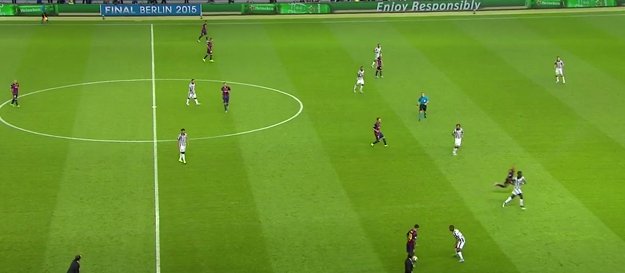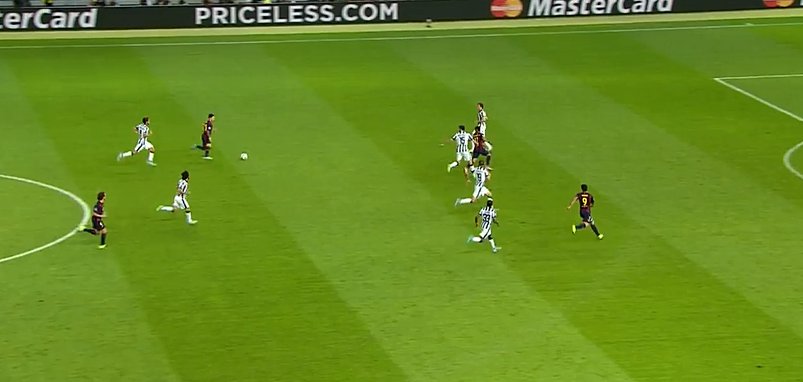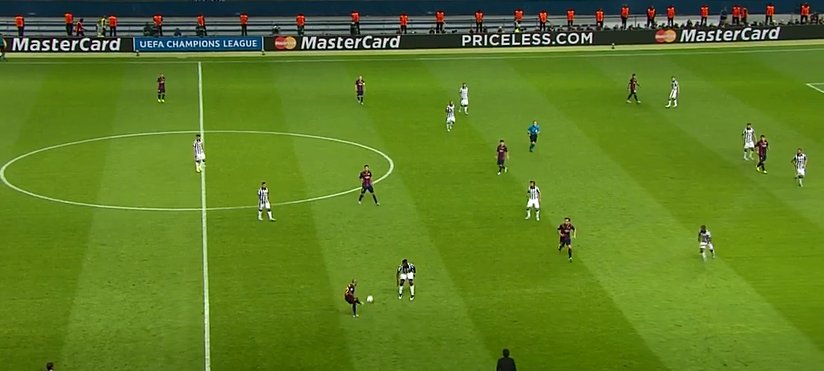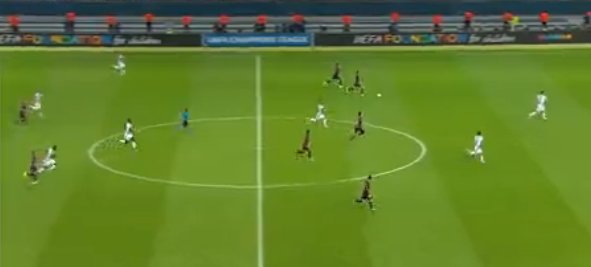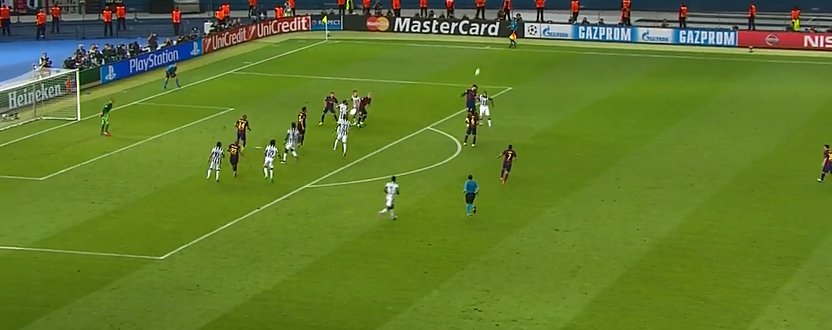By Stevie Grieve
This is the second of two posts looking at Barcelona's methods and tactics from the Champions League Final versus Juventus. This week we look at Barcelona's attacking process.
In the Juventus analysis, I looked at how they would try to stop Messi, which forced Barcelona to adjust and look for alternative routes to goal – they would often switch play and attack from Neymar and Jordi Alba.
If Alves was high, Alba stayed deep and vice versa, or if both were high, Busquets stayed deep to form a 3v2 situation at the back and cover the defence in the pre-transition phase.
They looked to play less of a positional game behind the opposition midfield than in La Liga and instead with more stability behind the ball, often making it look like a 3-4-1-2 with Messi the 1 in a wide position in the 1st half and more central in the 2nd half. This aided the circulation of the ball but game them limited chances to play through the Juventus midfield and look for 1-2s as is the normal solution they look for when there is a compact midfield and defensive unit.
Get Messi 1v1 and able to run through the defence
When the best 1v1 (and probably 1v2 and 1v3) dribbler in the world is in your team, you try to find ways to get the ball to him in a position to run with the ball and eliminate opponents.
In this match, his influence in running with the ball was limited to 2 or 3 parts in the 2nd half, where he created the winning goal for Suarez by making a run and shot which Buffon parried into Suarez to score, and on the counter attack, but the reasons for this were mainly due to Juventus closing down his space to work in, meaning Messi had to use his incredible range of passing to open up opportunities for Neymar and Jordi Alba (as discussed in Juventus overcompactness).
Rakitic fills in at Right back for Dani Alves who makes a forward run into the gap behind Evra which was open when he pressed out of line. Pogba tracks the run of Alves creating the space for Messi to dribble inside and attack Pirlo 1v1.
This was a rare occurrence as the conditions needed to create the space were often overloaded by Juventus who kept a spare man in the zone of Messi to play 2v1, usually Pogba and Pirlo/Morata.
On the counter attack, Messi runs at pace with no real options ahead of him, so he keeps going into the box before making a good shot which Buffon saves, only for Suarez to score from it for 2-1.
Stability in possession around and behind the ball
Against a team with 2 strikers who want to play 2v2 in attacking transition, Barcelona had to make sure that the area behind Messi who would be pressed in groups all game, was secure to recover loose balls, offer back passes to continue circulation, and ensure they could stop counter attacks early, preventing Juventus from breaking away in 2v2’s would be a test of positional discipline for Busquets, Alba and Alves who would always have to asses who was where and work out who would complete the 3v2 situation defensively.
Here we see Messi dribbling inside unopposed, with Alves rotating outside and Rakitic moving towards Pirlo to occupy him and stop the press. Busquets stays deeper as both full backs push higher.
This time, Messi is wide with a 2v1 ahead of him. The positioning of the midfield although spread, is still fairly compact, with Rakitic deep in the position of Alves and Alba in the far side channel, narrow enough to recover quickly while still able to get forward on the outside. Busquets and Iniesta stay central to circulate the ball but also cover the centre and block access, forcing the play wide.
In the 2nd half, as Messi went looking for the ball in the centre to create something himself, or to draw opponents away from the middle, we can see that the back 2 and Busquets secure the middle with all of Juventus except Tevez deep, the 2v1 at the back allows Barcelona to play a 2-1-6-1 shape, with Neymar ready to drift inside as Alba stays high and on the outside of the narrow diamond shape in midfield, with Suarez and Neymar occupying the defensive line.
The positioning of Rakitic and Iniesta just outside the line of the diamond is to stretch the midfield and support the full backs Alba and Alves who have freedom to push forward with nobody wide enough to track them and Busquets, Iniesta and Rakitic able to cover the full back zone in transition.
Messi in the centre to be more of an influence in the game
In the 2nd half, Messi was more often moved (maybe he decided?) into the centre to try and make a breakthrough by playing in a position to by-pass the midfield of Juventus by drawing players narrower to him and go down the outside, or go through Messi if the space was available.
Busquets is in a fantastic position to receive between the lines and find Messi in an attacking position with Iniesta ready to drift left and Rakitic to drift right with Alba and Alves deep, and Neymar and Suarez occupying the back 4.
Speed in attacking transition, especially from corner kicks
When Barcelona were under Pep Guardiola, a criticism of the team was the lack of counter attacking threat (or desire to counter attack?). Maybe this was due to Guardiola himself telling Marti Perarnau in his book, ‘Pep Confidential’ that he likes 15 passes to start the play to organise the players to be best protected against counter attacks as the players are in position to counter-press or react to cover the spaces the opponent will attack in transition.
[wpsharely id="2988"][/wpsharely]With Luis Enrique, Barcelona have become a more direct team, more willing to play on the counter attack as they can be forced deeper out of possession which can often suit the profiles of Neyma, Suarez and Messi as all 3 are quick, direct with the ball and look to run beyond the defence.
An example in the 2nd half of when Juventus opened up to attack and created a corner kick; Suarez headed the ball out and chased forward to help the counter attack 5v3, which resulted in a shot saved by Buffon from Suarez.
This is the 3rd goal, where Barcelona score from a 3v2 counter attack involving Pedro, Neymar and Messi. Pique (the spare man at set plays) wins the header and releases Pedro to find Messi and start the attack in the last 10 seconds of the match which leads to a goal by Neymar.
By Stevie Grieve. (Follow on Twitter @steviegrieve) Stevie is also the author Coaching the 4-2-3-1, Coaching the 4-2-3-1 Advanced Tactics and From Futsal to Soccer

